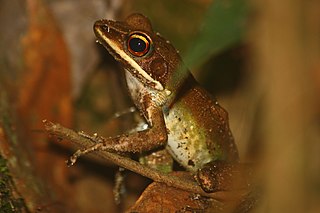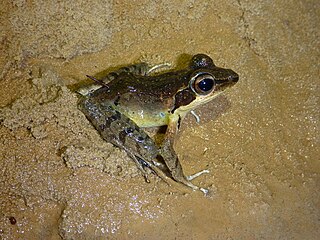
The true frogs, family Ranidae, have the widest distribution of any frog family. They are abundant throughout most of the world, occurring on all continents except Antarctica. The true frogs are present in North America, northern South America, Europe, Africa, and Asia. The Asian range extends across the East Indies to New Guinea and a single species has spread into the far north of Australia.

Amnirana is a genus of frogs in the family Ranidae, "true frogs". The genus is primarily found in Sub-Saharan Africa, but one species occurs in parts of southern and southeastern Asia. Some of the African species are widespread but contain undescribed cryptic diversity. Most species have a white upper lip, and the genus is sometimes known as the white-lipped frogs.

Indosylvirana aurantiaca, commonly known as the golden frog, is a species of frog endemic to the Western Ghats of India. The species is also known as the Trivandrum frog, the common wood frog, or the small wood frog.

Amnirana albolabris is a species of frog in the family Ranidae. It is widely distributed in Sub-Saharan West and Middle Africa. However, the nominal species includes at least one undescribed species west of Benin; the formal taxonomic changes to split the species have not yet been done. Common names white-lipped frog and forest white-lipped frog has been coined for it, whereas Bamileke Plateau frog refers to now-synonymized Amnirana longipes.
"Hylarana" chitwanensis is a species of frog in the family Ranidae endemic to Nepal. Its type locality is in the Chitwan National Park. Earlier reports from India are erroneous although it is likely to occur there.

The common green frog is a frog species of in the true frog family Ranidae; some sources still use the old name Rana erythraea. It lives in Southeast Asia and is also known as green paddy frog, red-eared frog or leaf frog. The last name, however, commonly refers to the Neotropical tree frogs which make up the subfamily Phyllomedusinae. These are not closely related to H. erythraea, belonging to family Hylidae instead.
Papurana garritor is a species of frog in the family Ranidae. It is endemic to New Guinea and widely distributed, found in both Indonesian and Papua New Guinean parts of the island. Common name Eilogo Estate frog has been coined for it.

"Hylarana" lateralis is a species of frog in the family Ranidae. It is found in Cambodia, Laos, Myanmar, Thailand, and Vietnam. It is commonly known as Kokarit frog, yellow frog or (ambiguously) wood frog.

"Hylarana" latouchii, also known as Kuatun frog, LaTouche's frog, or broad-folded frog, is a species of frog in the family Ranidae. It was formerly placed in genus Rana. The specific name honours the collector of the type series: "Hylarana" latouchii was described by George Albert Boulenger based on three specimens collected by Irish ornithologist John D. La Touche in Guadun village in Wuyishan, Fujian, China.

Hylarana tytleri is a frog species in the family Ranidae. It is found in eastern and northeastern India, Bangladesh, and southern Nepal, and possibly at lower elevations in Bhutan. It was formerly placed in Rana, and included in the common green frog. It is probably a close relative of that species nonetheless, and thus placed in the revalidated genus Hylarana, of which H. erythraea is the type species. Common name Theobald's ranid frog has been coined for it, although common names for Indian frogs previously identified as Rana erythraea include yellow-striped frog, leaf frog, and leaping frog.

Hylarana, commonly known as golden-backed frogs, is a genus of true frogs found in tropical Asia. It was formerly considered highly diverse, containing around 84 to 96 valid species, but taxonomic revision resulted in a major change in the contents of the genus, and today it is recognised as containing just four species.

Sylvirana is a genus of true frogs, family Ranidae, found in South and East Asia, from northeastern India in west to China in the north, Taiwan in the east, and Thailand in the south. Originally proposed as a subgenus of Rana in 1992, it has been considered both a full genus and a synonym of Hylarana. Its current recognition at generic level stems from molecular genetic analyses published in 2015.

Papurana is a genus of frogs in the family Ranidae, "true frogs". They are known from New Guinea, some nearby islands, and northern Australia. Papurana daemeli is the only ranid frog found in Australia.
"Hylarana" attigua is a species of frog in the family Ranidae, the "true frogs". The exact genus-level placement of this species is uncertain because it was not included in the revision of the genus Hylarana that saw what was then very broadly defined genus split into several distinct genera, with relatively few remaining in Hylaranasensu stricto. It is found in central and south Vietnam, eastern Cambodia, and southern Laos. The specific name attigua is derived from Latin attiguus meaning "neighbor". It refers to the similarity of this species to Indosylvirana milleti. Common name similar frog has been coined for this species.

Papurana elberti is a species of true frog. It is native to Indonesia and Timor-Leste and found on the islands of Timor and Wetar. The specific name elberti honours Johannes Elbert, a German naturalist who joined an expedition to the Lesser Sunda Islands and Sulawesi in 1910. Common name Lesser Sundas frog has been coined for it.

Hylarana taipehensis is a species of true frog, family Ranidae. It has several common names, including Taipei frog, Taipei grass frog, two-striped grass frog, or striped slender frog. It is found in northeastern India, Bhutan, Bangladesh, Myanmar, Thailand, Cambodia, Laos, Vietnam, southern China, Hong Kong, and Taiwan. There is some uncertainty about the identity of specimens from India.

Papurana florensis is a species of true frog. It is native to the islands of Lombok, Sumbawa, and Flores in Indonesia. Common names Floresian frog and Flores frog have been coined for it.

Hylarana leptoglossa, commonly known as the long-tongued frog, is a species of true frog in the genus Hylarana. It is native to Bangladesh, northeastern India, Myanmar, and western Thailand. It is also known under the common names Cope's frog, Cope's Assam frog, palebrown small frog, and Assam forest frog. It has recently been reported also from Bhutan.

Papurana moluccana is a species of true frog. It is endemic to the Maluku Islands of Indonesia; specifically, it is known from Halmahera and Bacan. Common name Moluccas frog has been coined for it.

Papurana papua is a species of true frog, family Ranidae. It is endemic to New Guinea and found in the northern part of the island in both Indonesia and Papua New Guinea as well in some offshore islands. Common name Papua frog has been coined for it.
















